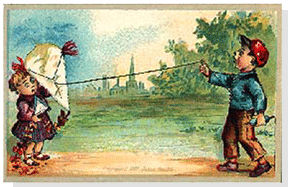How to Fly a Kite

Flying a kite can be done by anyone with a little patience and by following a few basic tips.
- Select an area that is free from trees, power lines and other obstructions. Large parks, vacant fields and soccer fields are perfect.
- Wait for the wind. Winds of 7-15 kmph (5-12 mph) are ideal. Winds blowing at that speed can be felt on your face. Leaves and twigs will be in motion. Wind between 12 -20 kmph (8 - 12 mph) will extend flags out. Flying is possible in winds of 3-6 kmph (2-3)mph) if your kite is light enough and you patiently work the kite into the air.
- Turn your back to the wind. Have a friend walk your kite out at least 20 metres (60 feet) downwind, holding the kite loosely. Pull the line snug. When the kite catches a breeze, pull on the line until the kite gains altitude. If necessary, walk backwards to keep the kite aloft. Be careful to look behind you to ensure your safety.
- If you are alone, place an anchor such as a tent stake or peg into the ground. Tie your kite line around the peg and walk the kite out yourself to a distance of 20 metres or so. Pull the kite line snug and prop the kite up to get it ready to launch. Return to the peg where the line is tied and pick up the line. Pull on the line when you feel a breeze. Once the kite begins to lift off pull on the line to increase altitude.
That is all it takes to launch a kite and have pleasure at the end of your kite line.
To land the kite, release tension on the kite line to allow the kite to slowly drift to the ground. If the kite is pulling hard and will not land when you let out some line, place a peg in the ground and tie your kite line to the peg. Then reach out for the line and walk towards the kite pulling the line down hand over hand. This will "walk the kite down" to the ground where you can safely pack it up for another day.
Some useful equipment to have with you:
- a long tent peg (30 cm or 12 in.) and perhaps a hammer to put the stake into firm ground;
- a pair of gloves to protect your hands. Kite line can burn and cut as it slips through your hands, pulled by a strong kite in the wind.
Special Safety Reminders!
- Do not fly near power lines or traffic!
- Large kites should always be securely staked out and the kite line tied to the stake prior to launch.
- If your kite gets away and gets tangled in power lines do not attempt to get it down!
- If your kite is tangled in a tree or high altitude spot do not worry about retrieving it. A lost kite is better than some broken bones. You can always make another kite.

For a more detailed outline of how to successfully fly a kite, the AKA (American Kitefliers Association) has developed a printable booklet that is useful for schools and individuals to promote safe and successful kite flying.
The book, entitled How To Fly A Kite was developed by Glenn Davison, a good friend of mine from the kite community. Glenn prepared the book for the AKA and it is essential for teachers, group leaders and kiters who wish to spread the joy and skill of kite flying to those that they meet.




